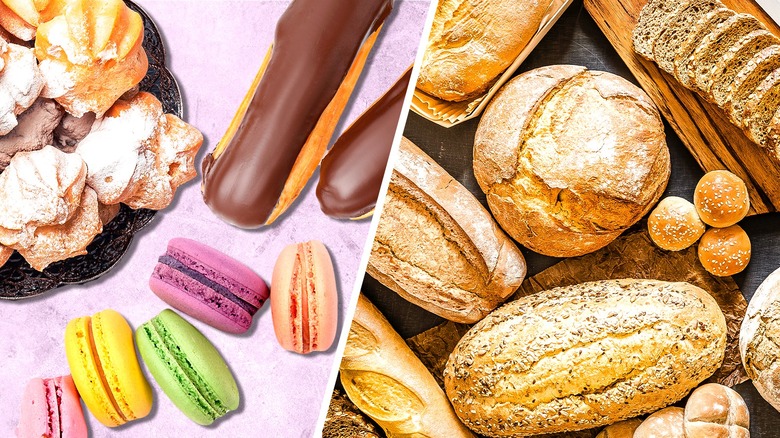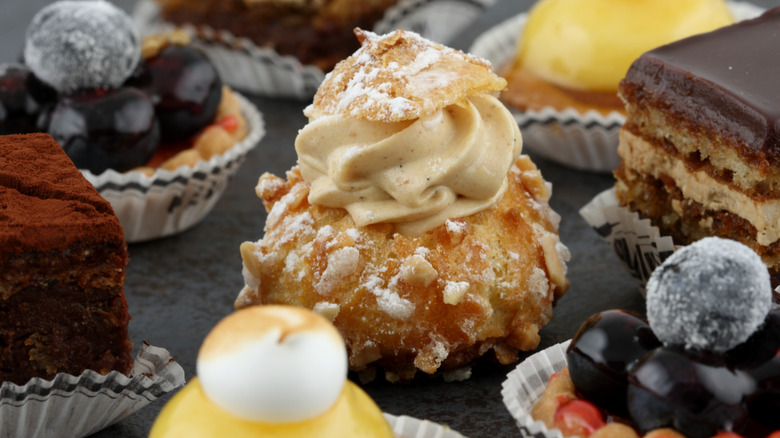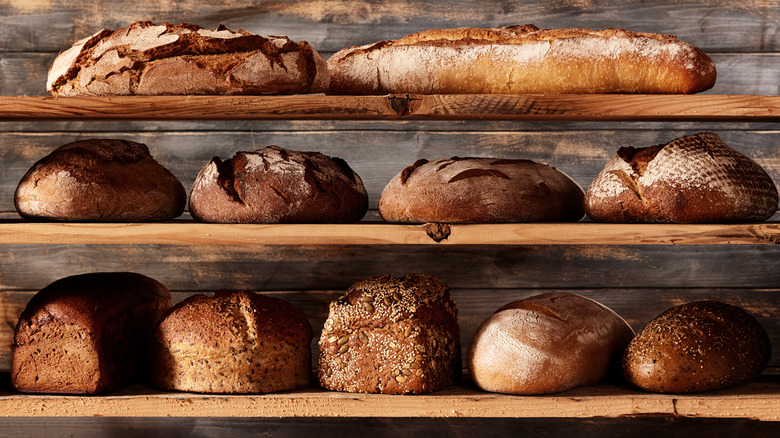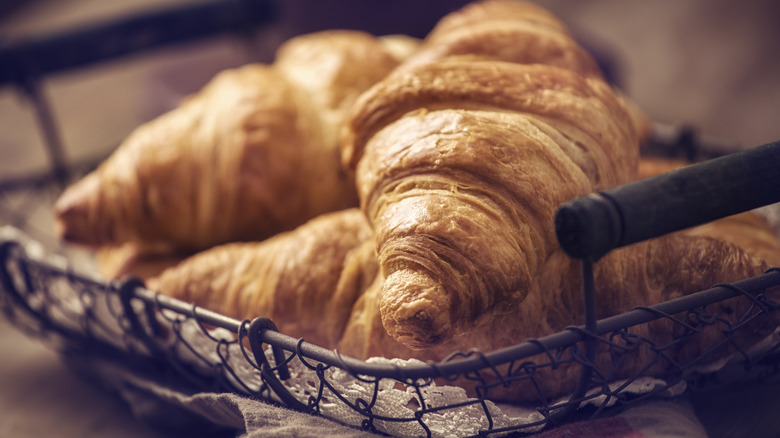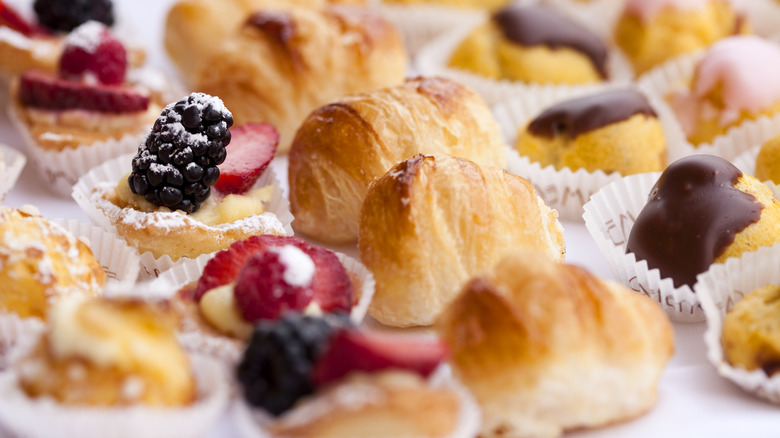The Important Difference Between Patisserie And Boulangerie
Is there anything better than bread and pastries? We'll wait while you try to think of something that ranks above fresh baked bread slathered in butter, or the absolute delight of biting into a crisp cream puff, and tasting that sweet filling. You've probably heard the term patisserie, but what about boulangerie or even viennoiserie? While the French baked goods that come under those names can be similar, there are extensive minutia distinguishing them.
Of course, bakers from other countries and geographic areas have markets for dessert, but none have as much influence on the culinary world as the French. While the word "patisserie" is simply French for pastry, it has taken on an even more complex and delicious meaning across Europe and other parts of the world. Boulangerie simply means "bakery" in the classic bread-shop sense of the word, whereas viennoiseries are pastry shops (and the pastries sold in them) that are connected to Austrian baking.
So, what's the difference between these French shops? Put simply, patisseries sell sweet delicacies, boulangeries sell breads, and viennoiseries sell sweet, flaky pastries. But how different can sweet dough and mild, salty dough really be? While it may seem like carbs are carbs are carbs, the depth of differences between these French categories gets extremely detailed. If that seems a little confusing, don't fret, we're going to break down the recipes.
What is a patisserie?
A patisserie is not only a sweet delicacy, but also a delightful shop in which you can acquire said delicacies. Appearing in France around the turn of the 19th century, patisseries are the picture of quintessentially fine dessert offerings. Just the word patisserie conjures thoughts of quaint, pastel storefronts, shop windows stacked with aesthetically displayed confections, and exquisitely sweet edible details. Though patisseries already existed, the renowned pastry chef and culinary author Marie-Antoine Carême revolutionized French desserts, and elevated humble pastries to the careful, avant-garde creations we fantasize about today.
A French patisserie is no ordinary bakery or sweet shop — an establishment can only truly bear the title if it employs a licensed maître pâtissier, or a master pastry chef. Offerings include the French classics like mille-feuille (layered pastry and cream), croquembouche (filled choux pastries stacked in a cone), macarons, ladyfingers, eclairs, madeleines, and other pastries with flavored creams and ganaches. These little works of art often feature doughs with a high moisture content, so that steam acts as a leavening agent in the baking process. Sweet, airy choux dough is also much lighter than a dense dough, so it can be piped, rather than rolled and cut.
What is a boulangerie?
Boulangerie is the French term for a shop most similar to our average conception of a bakery. Derived from the phrase for historical French country bread, "un pain boule," meaning "a ball bread," a boulangerie is all about one of the world's most universally beloved and varied foods: bread. Loaves of all shapes and sizes are crafted from dough, proofed, baked, and displayed every day in boulangeries across France.
Many American bakeries boast goods from donuts and breakfast pastries to cakes and cookies, but the French boulangerie has a narrower niche of offerings. They specialize in classic breads like the iconic baguette, pain de campagne (a large, round loaf), pain aux céréales (seed and cereal bread), pain de seigle (dark rye bread), and fougasse (similar to focaccia, with aromatics and vegetables baked into the top).
To be categorized as a boulangerie, a French bakery must bake all of its bread in-house, never outsourcing baked goods. True boulangeries cannot freeze the bread, or include preservatives or additives in the recipes, ensuring that the bread is of the highest, freshest quality. Notably, boulangerie offerings incorporate active yeast as a leavening agent, where patisseries do not.
Viennoiseries are the overlap between patisseries and boulangeries
Though similar, a viennoiserie and a patisserie are not interchangeable. In fact, a viennoiserie may even be closer to a boulangerie in its tasty offerings. Viennoiseries, meaning "things of Vienna" in French, are a sort of middle ground between the delicate, sweet goods of patisseries, and the hearty, bread goods of boulangeries.
Crispy and flaky on the outside, soft and light on the inside, viennoiseries are staple breakfast baked goods, from fruit and nut danishes to golden brown brioche buns. Though incredibly popular in France, viennoiseries have significant influence from Vienna, Austria. It may come as a shock to croissant lovers everywhere, but the quintessential French pastry shares history with Austrian desserts.
The French croissant as we know it today is an ancestor of the Austrian kipferl. Around the mid-19th century, the kipferl made its way from Austria to France. Denser and sweeter than a croissant, this dessert dating back to 13th century Austria was commonly filled with nuts. While viennoiseries are thought to be Austrian at their core, there's no doubt that the French have left their mark upon the pastries. The most famous viennoiseries include croissants, pains au chocolat, pains aux raisins (similar to the pain au chocolat, but with buttercream filling and raisins), and chausson aux pommes (apple turnovers).
Patisseries offer delicacies and boulangeries offer yeasty fare
Side by side, croquembouche, croissants, and pain de campagne couldn't be more disparate, so let's brush up on these important distinctions. Patisseries stretch our culinary imaginations with treats and trappings beyond the realm of everyday cooking and baking, while a boulangerie provides an impressive variety of high-quality breads that verge a bit more on the ordinary side of the oven.
Fancy, light, and visually artful desserts like mille-feuille, pâte à choux, petits fours, and croquembouche, encompass the delicacy of patisserie. Some patisseries even feature entremets, or desserts that don't incorporate dough, like charlottes, flans, and crème brûlée. Compared to the dainty elegance of a patisserie, a boulangerie tends to have a more rustic charm. But don't mistake that for mediocrity — bread from a boulangerie is of the utmost quality in ingredients, flavor, and freshness.
The viennoiserie is a sort of middle ground between the two ends of the spectrum, marrying sweetness, fillings, and toppings with heartier pastries intended for meals, usually breakfast. Of course, it's possible that a patisserie could serve a delectable pain au chocolat, or a boulangerie might offer an ultra-flaky croissant, but the moral of the story is that patisserie and boulangerie are much more refined and complex than the stereotypical conception of a bakery. Just be careful not to conflate the terminology, because you may be committing a bread and pastry faux pas.
